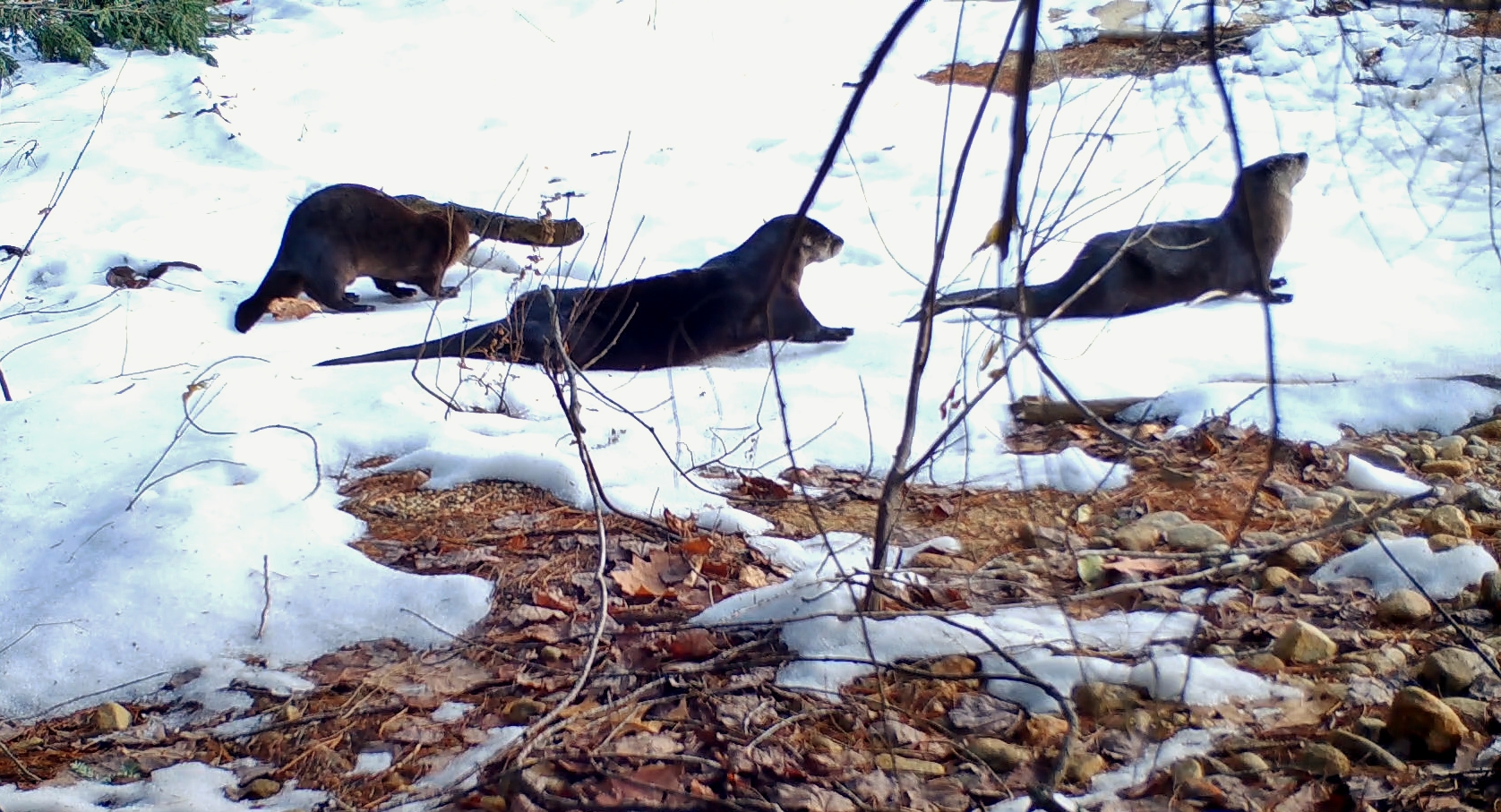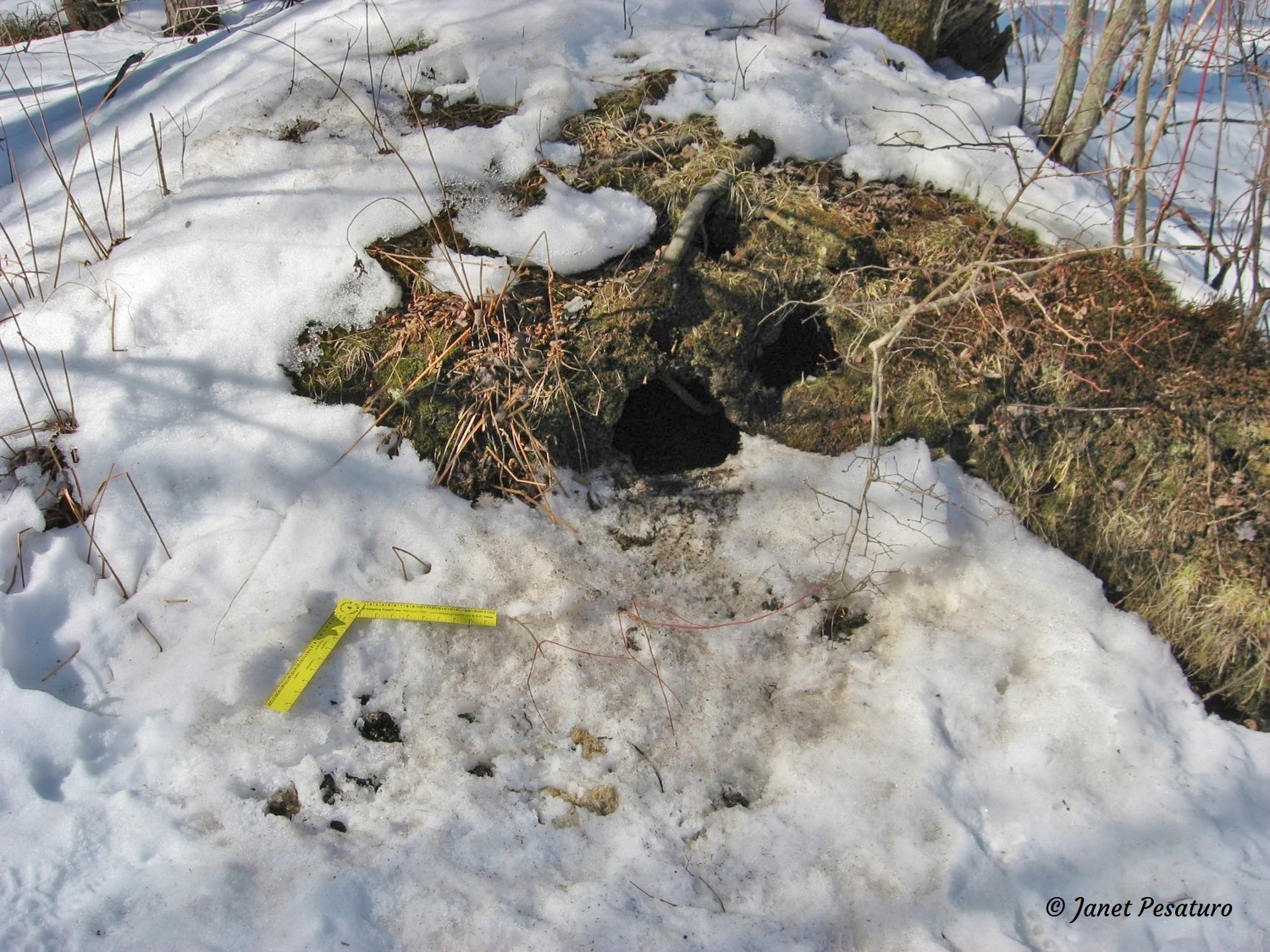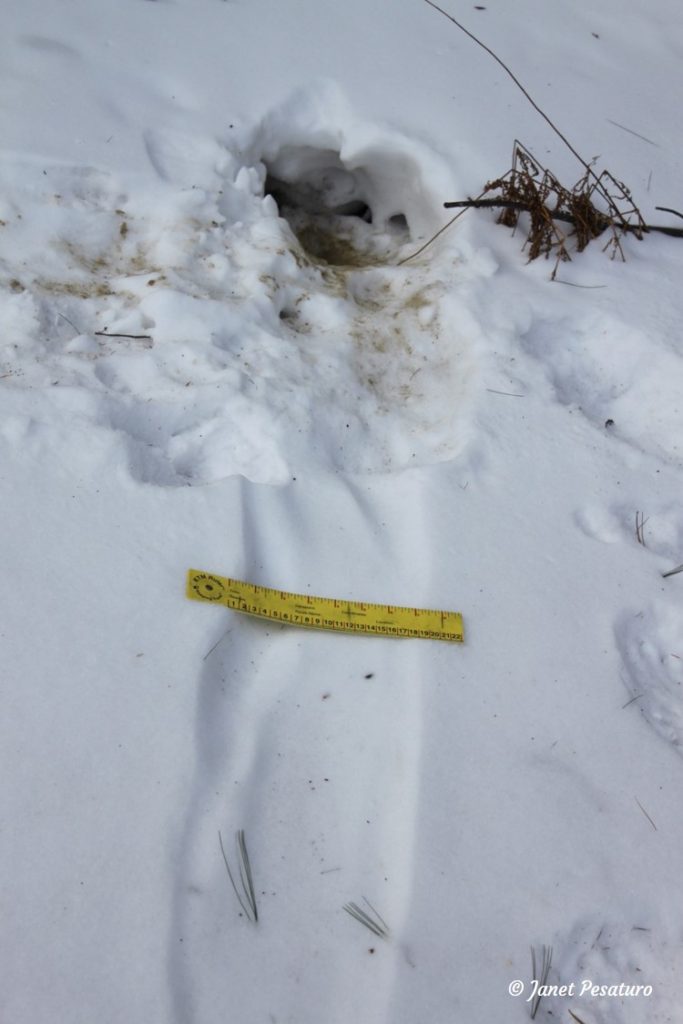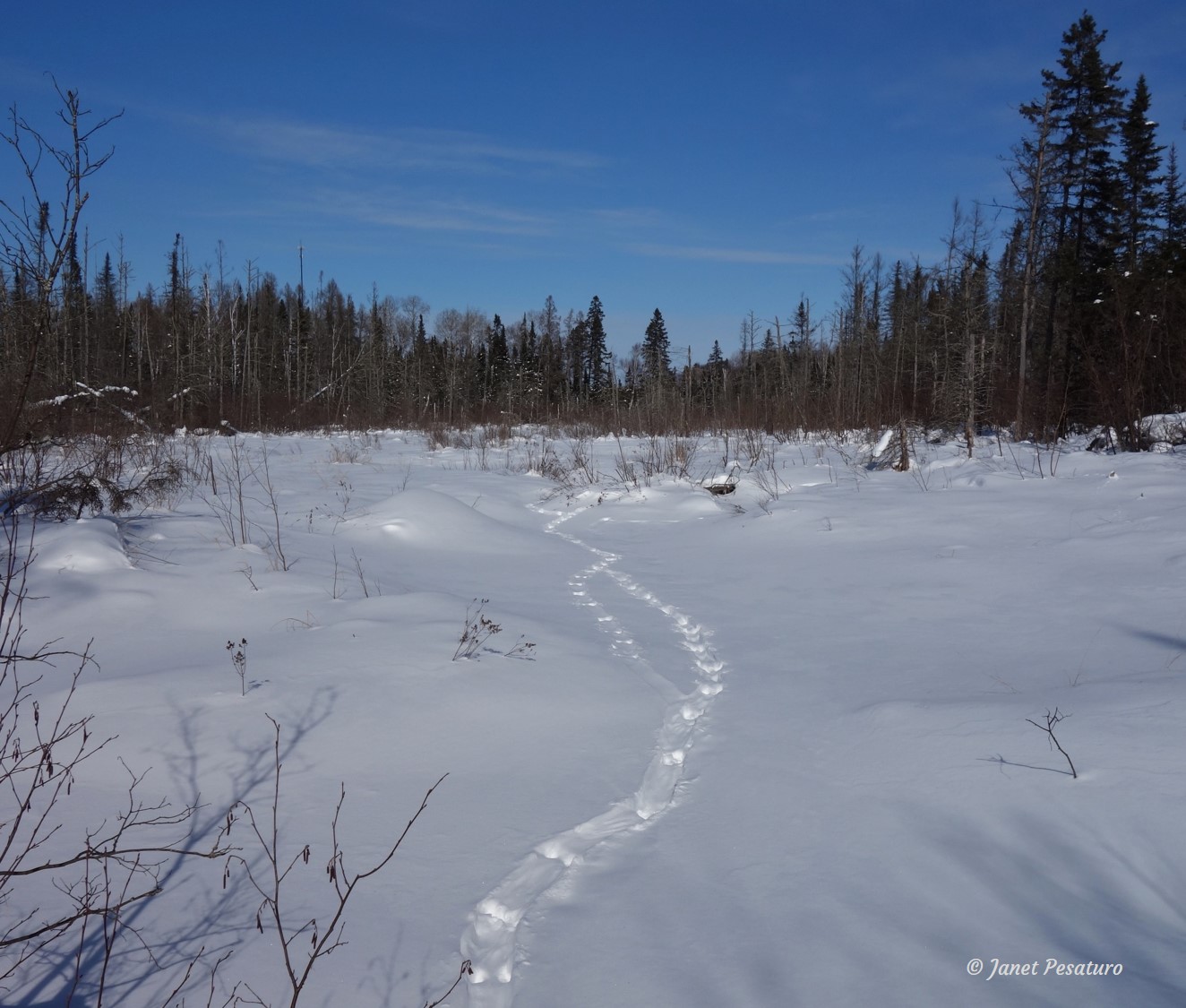River Otter Winter Adaptations

A recent trail camera video I captured at an otter latrine got me to thinking about river otter winter adaptations. These animals do not wait out the cold months in hibernation. On the contrary, they are active and appear comfortable – nay, joyful – in the snow. How is that? What allows them to thrive in cold, snowy conditions? Perhaps because I’ll soon be leading a Winter Field Ecology program, I thought I’d think this through systematically. What are the anatomic, behavioral, and physiological adaptations that allow North American river otters (Lontra canadensis) to thrive in the cold? Enjoy the video which prompted me to write this post, and then read on.
A little disclaimer before I start. Some might take issue with my calling some particular phenomenon a winter adaptation if it evolved for some other reason, and only happens to be of benefit during winter. For example, the otter’s ability to live singly or in groups may have evolved because it allows the animal to to better exploit food resources in general, and it just happens to boost winter survival in cold climates. To be honest, I don’t actually know for a fact that flexible social structure does improve winter survival. Really I am just brain storming here and I encourage you to give yourself the same freedom. Think about what you’ve seen while tracking otters, imagine what it’s like to be one in winter, and see what ideas pop into your head. Feel free to share them in a comment below.
Anatomic adaptations
An anatomic adaptation is a physical trait that improves survival. The most obvious physical characteristic that allows the river otter to cope with extreme cold is its dense, virtually waterproof fur coat. I am not sure if the winter coat is any thicker than the summer coat, but whether or no, the exceptionally dense undercoat keeps the otter warm and dry enough to hunt in icy cold water. At about 585 hairs per square millimeter, river otter fur is approximately 10 times denser than bobcat fur and red fox fur. This isn’t too surprising when you consider the fact that the otter needs to spend a considerable amount of time in water to find food. So while 60 hairs per square millimeter is sufficient for a terrestrial hunter in winter, about ten times that density is needed for an animal that hunts mostly in cold water. It’s interesting to note that the density of the mink’s fur is about 290 hairs per square millimeter, which is intermediate between the otter and the two terrestrial predators. This makes intuitive sense because the mink, a generalist which takes prey on land and in water, spends more time in water than either the bobcat or the fox, but less time than the otter.
Now let’s consider the shape of its body. The river otter has the typical body type of a mustelid: Long and slender with short limbs. That body type, with its high surface area to volume ratio, does not retain heat well, and poor heat retention is a liability in winter. Therefore, animals with long, slender bodies have to eat a lot to keep warm. However, that streamlined physique is also an asset: it lends efficiency to aquatic hunting.
So presumably it’s a balancing act. A chunkier body would allow the otter to better retain heat but would also reduce its agility in water and therefore its hunting efficiency. The otter needs to be slender and streamlined enough to hunt successfully but not so slender that the animal cannot get enough calories to keep warm. An overly chunky body would also make an otter more awkward on land, and therefore at greater risk of becoming another predator’s victim. It’s probably for these reasons that the otter depends on a thick, waterproof coat and excellent hunting ability instead of a layer of blubber to keep warm.
Behavioral adaptations
A behavioral adaptation is something the animal does to improve survival. One thing the river otter must do is care for that warm, waterproof coat. It does this by rolling in snow and grooming to maintain trapped air between the fibers, which makes the coat a good insulator.
Like many other mammals, otters make use of sheltered spaces to keep warm. Old beaver lodges are a popular choice. Space under logs or roots or in dense vegetation are sometimes used, as are abandoned burrows of woodchucks or other animals.

The river otter’s social interactions also help it survive winter. Young stay with their mother through their first winter. Sharing a den with her helps them keep warm, hunting with her helps them meet the increased caloric demands of maintaining body temperature in a cold environment, and mutual grooming helps them keep those dense, warm coats in good condition. Adult males may be solitary, but sometimes group together in “clubs” and may benefit each other similarly.
Hunting opportunities may be diminished after freeze up, but otters have ways of dealing with this. They seek streams and rivers where water does not freeze, and in ponds where water does freeze, they maintain holes in ice. Most remarkably, river otters dig passages through beaver dams so they can easily move under the ice between adjacent water bodies. This also lowers the water level which expands the breathing space under the ice and concentrates prey, thus improving hunting success.

Finally, otters save energy in winter by sliding on ice and snow in an efficient movement pattern that looks much like swimming. You can see an example of an otter sliding near the end of the video above. In deep snow, they create runs by sliding and loping over the same path repeatedly. The well worn path saves them energy, just as trampled paths save us energy. Trackers are familiar with slides and runs. Below is an example of otter slides in Minnesota.

Physiological adaptations
Physiological adaptations are internal body processes that make an animal better suited to certain environmental challenges. One physiological phenomenon in river otters that may in part be a winter adaptation, is delayed implantation of embryos. This is also called embryonic diapause. Mating takes place in early spring, but embryos remain dormant and free floating in the uterus for 8-9 months, before attaching and developing. As a result, babies are usually born in March in cold climates. This ensures that a female will not be burdened with young offspring during winter. And, if the mother is struggling, the embryos may never implant. Without the additional energetic demands of pregnancy, her own chances of surviving winter are enhanced. This is an important adaptation because the mother, having reached adulthood, is already a “success” and therefore more important to the gene pool than her young, many of which die before reaching adulthood. (I got the idea that embryonic diapause in some mustelids may be a winter adaptation from Rebecca Watters, author of the Wolverine Blog, when she presented in Massachusetts in January, 2020. I hope I haven’t misrepresented her thoughts. Perhaps she will correct me if I did.)
Related Posts
Sources
- Davis, R. D. “Metabolism and Thermoregulation.” In Marine Mammals: Adaptations for an Aquatic Life, 70. Cham, Switzerland: Springer, 2019.
- Kruuk, H. Otters: Ecology, Behavior and Conservation. New York, NY: Oxford University Press, 2006.
- Reid, D. G., S. M. Herrero and T. E. Code. “River Otters as Agents of Water Loss From Beaver Dams.” Journal of Mammology.” 69 (1988): 100-107.

This was a very interesting !I enjoyed learning through both venues, the video and written article.
Glad to hear that, Lynn. Likewise, I enjoy your photography on facebook!
Awesome video!
What camera did you use, haven’t gonna one,yet.
Thanks Becky! This one was taken with a Browning Spec Ops Advantage, which I love. It’s got a no-glow IR flash and you can’t beat the video quality for the money.
Thanks!!!!
A wealth of otter information! Thank you!! Going to imagine being an otter today. ?
That’s an otterly wonderful idea! 😉
Really enjoyed this and learning more about otters. Encouraged me to think more about winter adaptations of other creatures. Thanks!
My pleasure. I’m glad you found it useful.
Janet!
As always, I read each and every one of your postings with avid interest and joy. Thank you for these wonderfully informative and entertaining efforts. Cannot wait to join you on the 1st! (Have you read Bob Arnebeck’s online post entitled: “Otters Breaching Beaver Dams?” He cites Reid, Herrero, and Code, too, plus adds his own interesting observations.
Hi Lori! Yes, I read his post a while back, but should reread it, because I forget what his own observations were. I too am looking forward to the 1st. This post was kind of my practice for that outing – for thinking about each species’ winter adaptations.
Jan 25, 2025. My husband and I are on the Gull River west of Brainerd/Baxter MN near to where it flows into the Crow Wing River. We have always thought that we had muskrats in the banks of the river. However, this morning we saw a sleek brown mammal running and sliding along the snowy river. A couple of paces, then sliding, and repeat. Body seemed too sleek for a muskrat, and tail seemed thicker. Sure enough, we found a video of an otter sliding along a snowy surface. It appears that we have had otters all along, not muskrats. Unable to capture photo sor videos.
Very cool! Thanks for sharing.